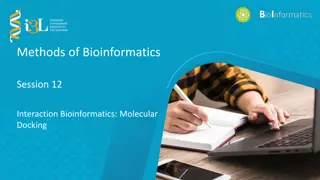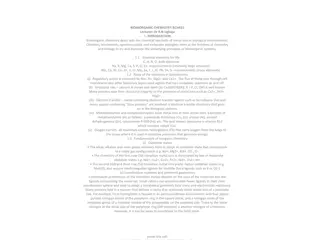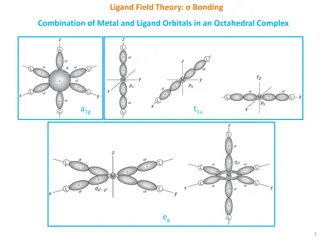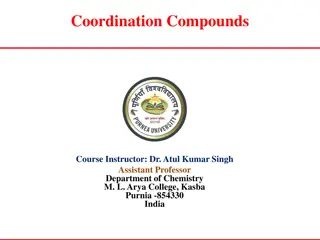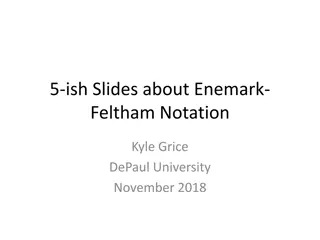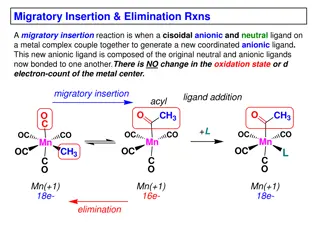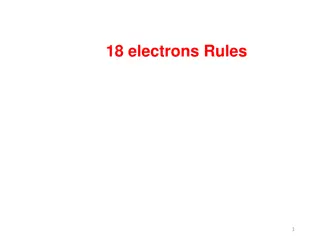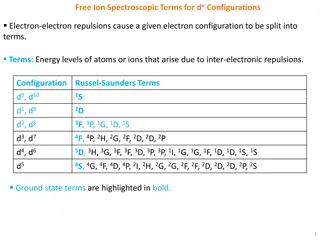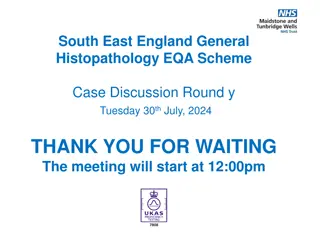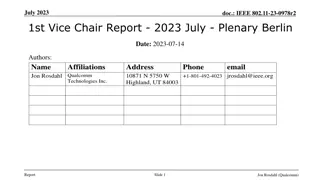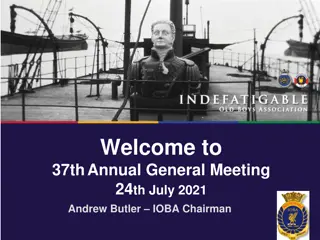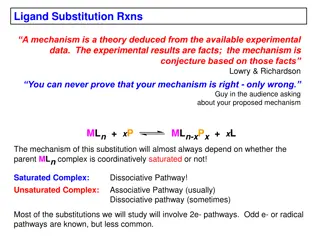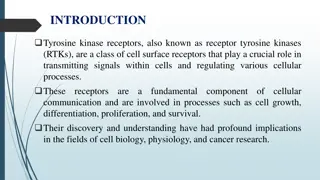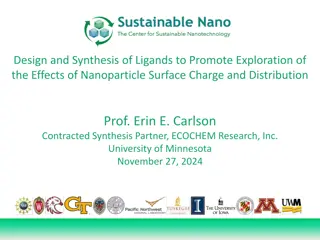
Advanced Crystallography Developments
Explore recent advancements including outlier analysis, regeneration of bond values, validation processes, and database improvements in Crystallography Open Database (COD) and CCP4 Monomer Library. Learn about the challenges and solutions in handling chemical data for crystallography applications.
Download Presentation

Please find below an Image/Link to download the presentation.
The content on the website is provided AS IS for your information and personal use only. It may not be sold, licensed, or shared on other websites without obtaining consent from the author. If you encounter any issues during the download, it is possible that the publisher has removed the file from their server.
You are allowed to download the files provided on this website for personal or commercial use, subject to the condition that they are used lawfully. All files are the property of their respective owners.
The content on the website is provided AS IS for your information and personal use only. It may not be sold, licensed, or shared on other websites without obtaining consent from the author.
E N D
Presentation Transcript
Recent developments 1) Tests (outlier analysis) and Bug fixing ( with Paul) 2) Regeneration of Values of Bonds and Bond-angles existing all structures in (COD). In the current version, we use those values provided by COD. We will replace them using our own data of bonds and bond-angles. 3) Validation and systematical analysis of those values and bug fixing( with Rob). 4) Different input file formats. (MMCIF , MDL/SDF , SMILE) 5) All codes and building are in CCP4 bzr repository (nightly building) 6) Have been presented AsAc2013 and will be presented in IUCR-2014 7) Release.
Introduction Crystallography Open Database(COD) The database contains crystal structures of organic, inorganic, metal-organic compounds and minerals. All structures are published in peer-review journals, and the database is freely accessible. About 250,000 structures, daily updated. Unique definitions of atom types.
Introduction Current CCP4 Monomer Library (Dictionary) Dictionary is used as the source for prior chemical information in CCP4 refinement program REFMAC, and other programs such as PHENIX and COOT. It contains: More than 10000 monomer entries More than 100 modification More than 200 links More than 100 atom types Improvement needed: The data need better supporting More atom types to take account of various chemical environment around atoms, particularly for metal atoms. That leads some problems in handle with unknown ligands.
Building the new Dictionary Classification of atoms in COD Atoms in are classified using local graphs Atom C9 C[5,5,6](C[5,5]CHH)(C[5,6]CHH)(C[5,6]CHO)(H) Atom C10 C[5,5](C[5,5,6]CCH)2(H)2 We have more than 600,000 atom types We need to cluster them and use fast search algorithms The atom types could be applied to other databases
Building the new Dictionary Statistical analysis data in COD Selection of records for bond and bond-angle The data are from single-crystal X-ray crystallography Robs< 0.05 Occupancies > 0.99 We handle atoms in organic set and metal atoms differently. After curating the data, we have the following for organic atoms More than 200,000 atom types More than 1.5 million distinct bond values More than 2.5 million distinct bond-angle value
Building the new Dictionary Statistical analysis data in COD Further check: Non-normality Multimodality Skewness Outliers Very tedious ! The work is under way.
Building the new Dictionary Statistical analysis data in COD Benchmark:
Building the new Dictionary Clustering the data from COD The new Dictionary requires: fast search for user s atom types (therefore bonds, angles, etc.), if these atom types exist in the Dictionary. find the most similar atom types if user s atom types do not exist. This leads to: hierarchical tree clustering of atom types Isomorphism mapping algorithm
Building the new Dictionary Clustering the data from COD Hierarchical tree clustering of atom types Hash number 1st NB composition 1st NB connection Atom type
Building the new Dictionary Clustering the data from COD Hierarchical tree clustering of atom types Hash number: a number, e.g. 455, embed minimally required property of atom type for matching, equivalent to the old CCP4 atom types 1st NB connection to 2nd NB, e.g. 3:3:1 2nd NB composition and connection to first NB, e.g. C[6]-3:C[6]-3:H-1: Full atom type, e.g. C[6](C[6]CH)(C[6]NN)(H) A full record entry of a bond between two organic atoms : 29 29 3:3:1: 3:2:3: C[6]-3:C[6]-3:H-1: C[6]-3:N[6]-2:N-3: C[6](C[6]CH)(C[6]NN)(H) C[6](C[6]CH)(N[6]C)(NCC) 1.3864 0.020 165
Building the new Dictionary Clustering the data from COD A search algorithm based on local graph isomorphism Search layer by layer until exactly matching atom types are found If no exactly matching atom types are found If it is at layer or lower, using average values at this layer If it is above layer, calculate the distance between all search atom types at that layer and target atom type. Select atom type of the smallest distance If search failed at layer, the simplest atom types will be used.
Building the new Dictionary Clustering the data from COD Bond values Atom type 1 111 Atom type 2 673 Atom type 1 111 Atom type 2 673 Atom type 1 111 Atom type 2 673 4:3: 4:2:1:1: 4:3: 2:1:1:1: 4:3: 2:1:1:1: C-4:C- 3: C-4:O- 2:H- 1:H-1: E C-4:C- 3: O-2:H- 1:H- 1:H-1: B C-4:C- 3: O-2:H- 1:H- 1:H-1: B D 1.4586 0.020 2516 C 1.4443 0.014 193 A 1.4484 0.014 4258 Value Value Value Nobs Nobs Nobs
Building the new Dictionary Clustering the data from COD Metal-organic compounds: Metal-organic compounds are clustering according to their coordination numbers and geometries New dictionary includes 26 coordination geometries and the angles within these geometries are stores as tables For an organic atom that is connected to metal atoms, its non-metal neighbor atoms are treated as described before
Two Associated software tools 1) A generator of molecule geometries is developed for users to assess the values of bonds, bond- angles, torsion-angles, planes etc. from the Dictionary for their new ligands and molecules An initial molecule geometry is generated using the bonds, angles etc. from the new Dictionary A global optimization scheme is carried out to bring the initial geometry to the ideal one It will replace the current CCP4 program libcheck as the engine for another program Jligand
Generator of molecule geometries using the new Dictionary A greedy global optimization scheme ? ? ? ? ? ? ? ? ? ? ? ? ? ? ? ? ? ? ? ? ? ? ? Original? function? ? Transformed? function? ? Local? minimization? stage? Tunneling? stage?
Generator of molecule geometries using the new Dictionary Examples DDI CGL
Two Associated software tools 2) A generator of ideal bonds and bond-angles based on the coordinates and our classification of atoms. This is for some sources, e.g. some pharmaceutical companies who might not be able to provide the details of ligands they have, but willing to provide the derived properties such as values of bond and bond angles. We need these data to enrich our database which is currently based solely on COD. Samples of the output are : 1.3891005 C48 c[6](c[6]CH)2(H) 1 C49 c[6](c[6]CC)(c[6]CH)(H) 1 1.3834940 C4_1_556 c[6](C[6]CC)(C[6]CH)(H) 1 C3 C[6(c[6]CH)2(CCHH) 1
Summary and future work An initial version of the new CCP4 monomer library, Dictionary, and the associated software tools have been developed and will be released soon(beta release before Xamas holiday). The Dictionary is based on openly accessible database of small molecule crystal structures, Crystallography Open database Some further work: Statistical analysis and validation of COD data, in particular on metal-organic compounds QM calculation on unknown ligands
Acknowledgement Other contributors: Garib Murshudov Saulius Grazulis, and Andrius Merky Thanks to: Paul Emsley, Rob Nicholls, Andrea Thorn Andrey Lebedev, CCP4 core team

